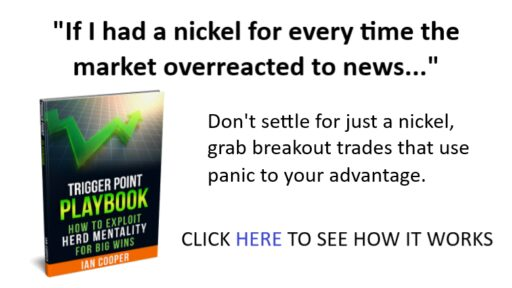by TradeWins Publishing Editors
It’s a fact that markets often go sideways. These strategies can give you a real trading edge.

A Quick Introduction
A strategy designed to collect premium from both sides of a market.
Dual Credit Spreads are a way to sell out of the money options that have a high mathematical probability of expiring worthless… without the uncomfortable and unlimited risk associated with “naked option selling”. Simply put, we sell an option outside of the range we think the market will trade in and then we buy a cheaper one even farther out for insurance in case the market does make a big move. If the market stays within the range between the options we sold, we win.
A trader does not need to guess where a market will go….only where it won’t go! (We think that may be easier to do most of the time unless you have a really good crystal ball.)

Dual Credit Spreads are normally initiated monthly, approximately 25 to 45 days prior to expiration. Longer periods can be used, but we prefer to work within the period of the most rapid option time decay.
Dual Credit Spreads: A Detailed Explanation
The “Dual Credit Spread” position in calls and puts is also known as an “Iron Condor” position in the language of options. It is a “long” Condor because the trader is buying (long) the outer strikes or “wings,” and selling the strikes nearer the market. The “Iron” refers to the fact that it involves vertical spreads in both puts and calls. Seen another way, the Condor position involves a long option “strangle” (long a call and put), and a short option strangle closer to the market, in the same expiration month.

Risk control in Dual Credit Spreads. If the “Dual credit spread” strategy has been used, with both calls and puts being sold, and the size of both spreads is equal, then the maximum risk is defined by the total potential value of either spread (calls or puts), minus the credit received for both, plus commissions and fees. This is because, at option expiration, only one “side” of the trade, either the call spread or the put spread, has the potential to have value.
Let’s look at an example from June 20, 2000:
Summary of Recommended Positions

Excerpt from trading comments:
In the S&P 500…..Credit spreads have been working well, and those are suggested for new trades. The market is trading in the area that might be good to collect premium from call credit spreads in July, and put credit spreads can be added on declines. Even though the market is encouraged by expectations that the Fed may not tighten rates any more at the meeting next week, a significant rally is not expected (or else call credit spreads wouldn’t be suggested here).
At that time, the July options being suggested expired in a little more than 4 weeks, and the options on both sides were well away from the market price. Because the market had been trading in normal “swings,” the idea was to sell the call credit spreads near the higher part of the expected range, and sell the put credit spreads on a decline in the market. This strategy of “legging in” involves a little of the “art of trading,” but it can allow the trader to collect more premium.
Here’s a chart of the September SP during that time (July SP options are “serial options” that expire monthly and are indexed to the quarterly September futures contract).

Let’s take a look at the example above, using both calls and puts. The call credit spreads and put credit spreads that were suggested were both 1000 points “wide”. Since each 100 points in the S&P futures and options represents $250 in value, each spread had a maximum potential value of $2500 at option expiration. If each side of the trade brought in 200 points or more as suggested, then a total of 400 points in option premium would have been collected ($1000). So the total risk at option expiration is the maximum spread value of $2500, minus the $1000 credit collected, for a maximum risk of $1500, plus commissions and fees.
In this example, even though the reward is smaller than the risk, the trader can expect a higher percentage of winning trades than losers. The key is that, by staying far enough away from the market with the credit spreads used, the “probability” of the market reaching either side at expiration is smaller than if spreads closer to the market are used.
Establishing the risk plan for a credit spread is a variable that must be decided by the individual trader, depending on account size, risk tolerance, and market outlook. Some traders may decide to limit the risk to a certain amount of “drawdown” in the trade, while others may decide to take the “full risk” in these positions, since the maximum risk is a defined amount.
One important point to remember about the risk for any credit spread is that even though the trade may suffer a “drawdown,” or show a loss before expiration, it is only after option expiration that this loss will actually be realized. In other words, it won’t matter if the market trades to or beyond the strikes being used in the credit spreads before expiration, as long as it’s not there when the options expire.
An extreme example of how these trades can recover from a drawdown can be found in a recent trade in the October 2000 SP options, where the “dual credit spread” strategy had been suggested. On the put side, the trade used the October 1410-1400 put credit spread at 200 points premium or more. Although the market traded all the way down to about 1325 just two days before option expiration, the market staged a strong rally and the market settled on Friday at 1411, and both options expired worthless. You can’t “cut it much closer” than that, but that’s what happened. Some traders might have closed these positions at losses according to their individual risk plans, but in this case, those who held the trades were able to collect all the premium from both calls and puts for the October 2000 SP futures expiration cycle.
Another example of a Dual Credit Spread.

Dual Credit Spreads: Questions and Answers
Which markets are this strategy used in?
The S&P500 market is one of our favorites for this strategy. Other markets such as T-Bonds and some of the foreign currency futures can be used from time to time when the option premium is adequate.
When do the trades for this strategy take place?
Dual Credit Spreads are normally initiated monthly, approximately 25 to 45 days prior to expiration. Longer periods can be used but we prefer to work within the period of the most rapid option time decay.
Does this strategy use options or futures contracts?
Only options are used. The strategy depends on “time decay” of option premium.
How are the option strike prices determined for this strategy?
We use both technical and fundamental analysis to establish what we believe to be the support and resistance levels for the recent market action. We then choose the option strike prices that would be beyond those levels. We simply try to establish where the market is less likely to go, rather than try to predict where it will go.
What is the maximum risk for this strategy?
Maximum Risk is defined by the dollar equivalent difference between the strike price sold and the strike price bought, less the credit collected, plus commissions and fees.
What is the maximum profit potential for this strategy?
Maximum Profit Potential is the amount collected on the sold options, less the amount paid out for the purchased options, less commissions and fees.
How much of my time will it take to use this strategy?
It is up to you how closely you wish to follow each trade. Stop loss orders and profit objective orders may be taken at the same time as the entry order. This allows you to continue trading even when you are busy or on vacation. There is generally no need to be glued to a quote screen all day.
How much trading capital does this strategy require?
Although margin requirements are not excessive most of the time (approx. $2500 per position in the S&P 500), we think that it is wise to have a $5,000 to $10,000 per position available to work with. A position can, however, be done with as little as $3,000 per position.
Dual Credit Spreads: Summary of Benefits
It is our opinion that Dual Credit Spreads, when done in a systematic, consistent, and disciplined manner, can offer the following benefits to a trader:
- Benefits from positive option time decay.
- Based on mathematical probability, rather than predicting direction.
- Profit Potential over a wide range of underlying futures prices.
- Can be tailored to fit a bullish, bearish, or neutral market outlook.
- Has defined and limited risk on each trade.
- Allows participation in the S&P 500 market with modest margin requirement.











Recent Comments